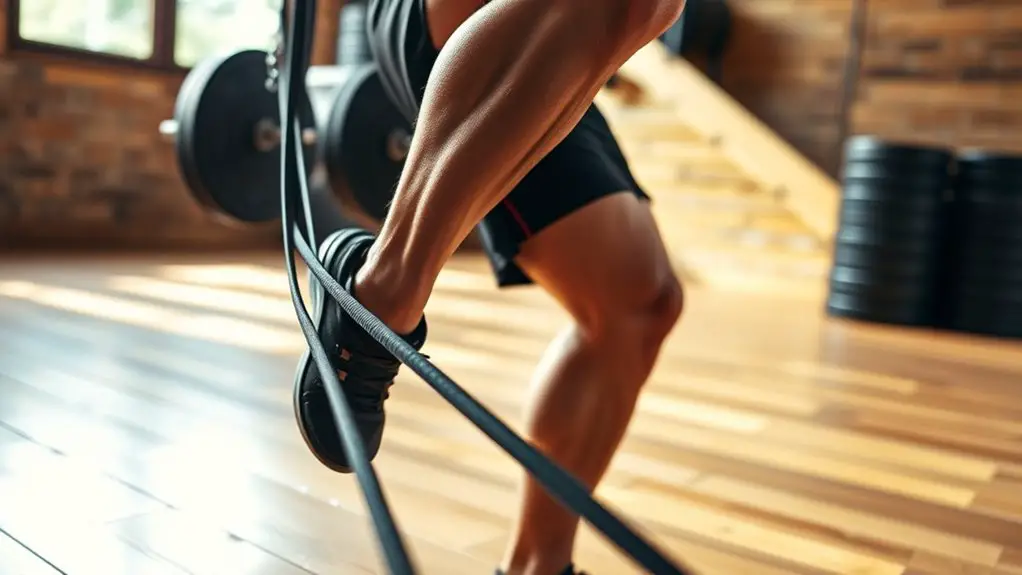How to Strengthen Your Hamstrings for Better Performance

To strengthen your hamstrings for better performance, focus on bodyweight exercises like lunges, glute bridges, and single-leg deadlifts. Incorporate dynamic stretching before workouts, and static stretching after to improve flexibility. Aim for two to three hamstring training sessions each week with proper rest. Nutrition also plays a crucial role; prioritize post-workout meals rich in protein and healthy carbs. By fine-tuning your routine, you can enhance strength and reduce injury risks, and there’s more to discover.
Understanding the Importance of Hamstring Strength

Hamstring strength plays an essential role in your overall athletic performance and injury prevention. Understanding hamstring anatomy helps you appreciate how these muscles work. Located at the back of your thigh, the hamstrings consist of three main muscles: the semitendinosus, semimembranosus, and biceps femoris. Their primary muscle function is to flex your knee and extend your hip, which is vital for activities like running, jumping, and cycling.
When your hamstrings are strong, they can better support your movements, maintaining balance and stability. This strength also aids in absorbing the force generated during high-impact activities, reducing the risk of strains and tears. Prioritizing hamstring strength not only enhances your athletic capabilities but also guarantees you’re taking the necessary steps toward a safer, more effective training regimen. By focusing on these muscles, you’re investing in your overall fitness and well-being.
Common Hamstring Injuries and Their Causes
While engaging in physical activities, you might find yourself at risk for several common hamstring injuries, primarily strains and tears. These injuries often stem from muscle imbalances, where one muscle group is stronger than its counterpart, leading to stress on the hamstrings. Overuse injuries can also occur if you push too hard without adequate rest. Poor biomechanics during movement can put unnecessary strain on your hamstrings, increasing the likelihood of injury.
To minimize these risks, it’s essential to implement effective warm-up routines before activity. Properly warming up prepares your muscles and improves flexibility. Additionally, following structured recovery protocols after workouts can help your hamstrings recover adequately, preventing future injuries. By being mindful of these factors, you can protect yourself and maintain strong, healthy hamstrings, ultimately enhancing your overall performance.
Effective Hamstring Exercises

When it comes to strengthening your hamstrings, bodyweight exercises and resistance band workouts can be incredibly effective. These methods not only build strength but also improve flexibility and stability. Let’s explore some of the best options you can incorporate into your routine.
Bodyweight Exercises
To effectively strengthen your hamstrings, incorporating bodyweight exercises into your routine can be both practical and efficient. These exercises not only target your hamstrings but also enhance core stability and balance, making them safe choices for everyone. Here are a few effective options:
- Bodyweight lunges: These improve your movement patterns while engaging your hamstrings.
- Glute bridges: This exercise directly targets the hamstrings and glutes, supporting overall lower body strength.
- Single leg deadlifts: These elevate balance training and provide a solid workout for your hamstrings.
Adding dynamic stretches and squat variations can further enhance your routine. Remember to always focus on form and control to minimize injury risk while maximizing results!
Resistance Band Workouts
Incorporating resistance band workouts into your routine can take your hamstring strengthening efforts to the next level. These exercises utilize band resistance techniques, allowing you to target your hamstrings effectively while minimizing the risk of injury. Start with basic exercises such as banded leg curls or hip extensions, keeping the resistance moderate to guarantee proper form. As you progress, you can increase the resistance gradually. The band exercises benefits include improved muscle activation, flexibility, and enhanced stabilization, all vital for better performance. Always pay attention to your body; if you feel any discomfort, adjust the resistance or technique. Safety is key, so take your time and enjoy the process of building stronger hamstrings with resistance bands.
Incorporating Hamstring Training Into Your Routine
Incorporating hamstring training into your routine is essential for overall strength and injury prevention. You’ll want to combine effective exercises with a consistent schedule to see real progress. Let’s explore how often you should train your hamstrings and tips to keep advancing your workouts.
Importance of Hamstring Strength
Although many people focus on building their quadriceps and calves, neglecting your hamstrings can lead to imbalances and increase the risk of injury. Strong hamstrings play a vital role in enhancing hamstring function and improving your athletic performance. By incorporating hamstring training into your routine, you can achieve better overall strength and stability.
- Helps prevent injuries by balancing muscle strength
- Supports proper movement mechanics during sports
- Aids in recovery and reduces muscle soreness
Prioritizing hamstring strength not only protects you from potential injuries but also optimizes your performance in various activities. Remember, a well-rounded fitness regimen should include attention to all major muscle groups, particularly the often-overlooked hamstrings.
Effective Hamstring Exercises
To build on the importance of hamstring strength, it’s time to explore effective exercises that can easily fit into your routine. Start with dynamic stretches, like leg swings and walking lunges, to warm up those muscles and improve flexibility. Once you’re warmed up, incorporate plyometric drills such as jump squats and box jumps, which not only target your hamstrings but also enhance overall power and coordination. Remember to focus on proper form to avoid injury; landing softly and using controlled movements is key. You can also include resistance band exercises, like hamstring curls, for added strength. By consistently adding these exercises into your routine, you’ll see improvements in your performance while keeping your hamstrings safe and strong.
Frequency and Progression Tips
When you’re looking to strengthen your hamstrings, finding the right frequency and progression in your routine is essential for achieving ideal results. Start by following these frequency guidelines: aim for two to three hamstring workouts per week, allowing adequate rest between sessions to prevent injury. As you build strength, incorporate progression strategies that gradually increase intensity, such as adding weight or increasing repetitions.
- Focus on form and control to avoid strain.
- Mix in a variety of exercises to target different muscle fibers.
- Listen to your body; if you feel pain, it’s okay to take a step back.
The Role of Flexibility in Hamstring Health
Flexibility plays an essential role in maintaining hamstring health, as tight muscles can lead to discomfort and injuries. By incorporating dynamic stretching before workouts and static stretching afterward, you can enhance muscle elasticity and overall flexibility benefits. This combination is critical for injury prevention, allowing your muscles to adapt to various movements without strain.
Additionally, mobility exercises are important for improving your range of motion. They help guarantee that your hamstrings stay limber and responsive, which is fundamental for balance training and athletic performance. Regularly practicing these exercises can lead to significant range improvement, making your hamstrings more resilient against injuries.
Nutrition for Muscle Recovery and Growth

While you might focus on exercises to strengthen your hamstrings, nutrition plays an essential role in muscle recovery and growth. After your workouts, prioritizing post workout nutrition is key to repairing muscle fibers and promoting growth. Consuming adequate protein sources helps your body recover efficiently.
Nutrition is vital for muscle recovery; prioritize post workout meals rich in protein to support growth.
Here are some tips for effective post workout nutrition:
- Include lean proteins: Chicken, fish, or plant-based options like lentils and beans are great choices.
- Incorporate healthy carbs: Foods like sweet potatoes or whole grains can replenish energy stores.
- Stay hydrated: Drinking water or an electrolyte-rich beverage can aid in recovery.
Tips for Preventing Hamstring Injuries
To prevent hamstring injuries, it’s crucial to prioritize proper warm-up routines and strength training. Incorporating hamstring warm ups into your fitness regimen can greatly reduce your risk of injury. Here are some tips to keep your hamstrings safe and strong:
| Warm-Up Activity | Duration | Benefits |
|---|---|---|
| Dynamic Stretching | 5-10 minutes | Increases blood flow |
| Leg Swings | 10-15 reps | Improves flexibility |
| High Knees | 30 seconds | Engages core and legs |
| Butt Kicks | 30 seconds | Activates hamstrings |
| Hamstring Stretches | 5 minutes | Enhances muscle elasticity |
Always listen to your body when performing these exercises. If you feel any discomfort, stop immediately. Remember, consistent injury prevention efforts can lead to improved performance and a longer, healthier athletic career.
Tracking Your Progress and Setting Goals
Tracking your progress and setting goals are essential steps in strengthening your hamstrings effectively. By monitoring your improvements, you can guarantee you’re on the right path while minimizing the risk of injury. Here are a few tips to help you with progress tracking and goal setting:
- Keep a Training Journal: Write down your exercises, reps, and weights. This helps you see your progress over time.
- Set SMART Goals: Ensure your goals are Specific, Measurable, Achievable, Relevant, and Time-bound to keep you focused and motivated.
- Regularly Assess Your Strength: Schedule periodic tests of your hamstring strength to measure improvement and adjust your training accordingly.
Frequently Asked Questions
How Long Does It Take to See Hamstring Strength Improvements?
When it comes to seeing hamstring strength improvements, it typically takes about 4 to 8 weeks, depending on your training frequency and consistency. If you’re engaging in strength training two to three times a week, you’re likely to notice changes sooner. Remember, everyone’s recovery timeline varies, so listen to your body and guarantee you’re prioritizing safety to avoid injury. Gradual progression will help you build strength effectively and sustainably.
Can Hamstring Strength Affect My Overall Athletic Performance?
Yes, hamstring strength can greatly affect your overall athletic performance. Strong hamstrings not only enhance your athletic power but also play an essential role in injury prevention. When your hamstrings are well-conditioned, you reduce the risk of strains and tears, allowing for safer, more effective training. This strength translates into better sprinting, jumping, and overall agility, helping you perform at your best while minimizing the chance of injuries.
Are There Specific Sports That Require Stronger Hamstrings?
Isn’t it amusing how some sports, like basketball, require you to leap high while secretly asking for strong hamstrings? You wouldn’t want your sprinting to be hindered, would you? Similarly, in football, tackling demands powerful hamstrings to avoid injuries. So, while you’re out there showcasing your skills, remember that stronger hamstrings can keep you safer and enhance your performance. After all, who wouldn’t want to excel without the fear of injury?
What Are the Signs of an Overworked Hamstring?
If you’re wondering about the signs of an overworked hamstring, you might notice muscle tightness and pain sensitivity in the back of your thigh. You could feel discomfort during activities or even while resting. Swelling or bruising may also occur. It’s essential to listen to your body; if you experience these symptoms, consider resting and consulting a professional. Taking care of your hamstrings can prevent further injury and promote overall safety in your activities.
Should I Focus on One Leg at a Time for Strength Training?
Research shows that around 80% of athletes benefit from unilateral training, which focuses on one leg at a time. So, yes, you should definitely incorporate single leg exercises into your routine. This approach not only helps in building strength but also improves balance and stability. Just make sure you maintain proper form to prevent injuries. Focusing on one leg can also address imbalances, ensuring both legs develop equally over time.





